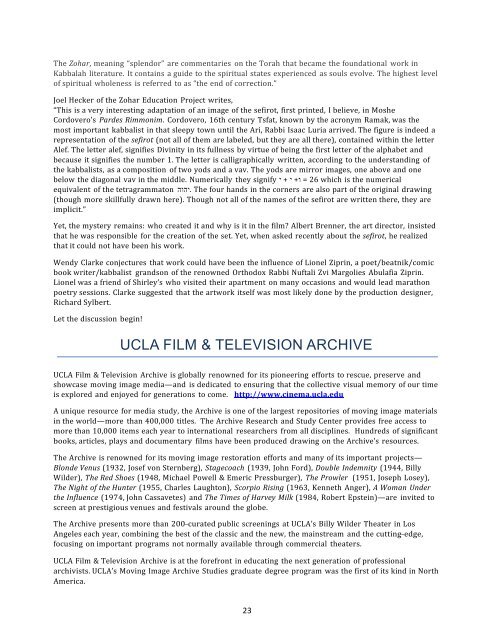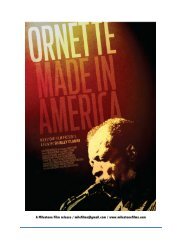Press Kit - Shirley Clarke
Press Kit - Shirley Clarke
Press Kit - Shirley Clarke
Create successful ePaper yourself
Turn your PDF publications into a flip-book with our unique Google optimized e-Paper software.
The Zohar, meaning “splendor” are commentaries on the Torah that became the foundational work in <br />
Kabbalah literature. It contains a guide to the spiritual states experienced as souls evolve. The highest level <br />
of spiritual wholeness is referred to as “the end of correction.” <br />
Joel Hecker of the Zohar Education Project writes, <br />
“This is a very interesting adaptation of an image of the sefirot, first printed, I believe, in Moshe <br />
Cordovero’s Pardes Rimmonim. Cordovero, 16th century Tsfat, known by the acronym Ramak, was the <br />
most important kabbalist in that sleepy town until the Ari, Rabbi Isaac Luria arrived. The figure is indeed a <br />
representation of the sefirot (not all of them are labeled, but they are all there), contained within the letter <br />
Alef. The letter alef, signifies Divinity in its fullness by virtue of being the first letter of the alphabet and <br />
because it signifies the number 1. The letter is calligraphically written, according to the understanding of <br />
the kabbalists, as a composition of two yods and a vav. The yods are mirror images, one above and one <br />
below the diagonal vav in the middle. Numerically they signify = ו+ י + י 26 which is the numerical <br />
equivalent of the tetragrammaton .יהוה The four hands in the corners are also part of the original drawing <br />
(though more skillfully drawn here). Though not all of the names of the sefirot are written there, they are <br />
implicit.” <br />
Yet, the mystery remains: who created it and why is it in the film? Albert Brenner, the art director, insisted <br />
that he was responsible for the creation of the set. Yet, when asked recently about the sefirot, he realized <br />
that it could not have been his work. <br />
Wendy <strong>Clarke</strong> conjectures that work could have been the influence of Lionel Ziprin, a poet/beatnik/comic <br />
book writer/kabbalist grandson of the renowned Orthodox Rabbi Nuftali Zvi Margolies Abulafia Ziprin. <br />
Lionel was a friend of <strong>Shirley</strong>’s who visited their apartment on many occasions and would lead marathon <br />
poetry sessions. <strong>Clarke</strong> suggested that the artwork itself was most likely done by the production designer, <br />
Richard Sylbert. <br />
Let the discussion begin! <br />
UCLA FILM & TELEVISION ARCHIVE<br />
UCLA Film & Television Archive is globally renowned for its pioneering efforts to rescue, preserve and <br />
showcase moving image media—and is dedicated to ensuring that the collective visual memory of our time <br />
is explored and enjoyed for generations to come. http://www.cinema.ucla.edu <br />
A unique resource for media study, the Archive is one of the largest repositories of moving image materials <br />
in the world—more than 400,000 titles. The Archive Research and Study Center provides free access to <br />
more than 10,000 items each year to international researchers from all disciplines. Hundreds of significant <br />
books, articles, plays and documentary films have been produced drawing on the Archive’s resources. <br />
The Archive is renowned for its moving image restoration efforts and many of its important projects—<br />
Blonde Venus (1932, Josef von Sternberg), Stagecoach (1939, John Ford), Double Indemnity (1944, Billy <br />
Wilder), The Red Shoes (1948, Michael Powell & Emeric <strong>Press</strong>burger), The Prowler (1951, Joseph Losey), <br />
The Night of the Hunter (1955, Charles Laughton), Scorpio Rising (1963, Kenneth Anger), A Woman Under <br />
the Influence (1974, John Cassavetes) and The Times of Harvey Milk (1984, Robert Epstein)—are invited to <br />
screen at prestigious venues and festivals around the globe. <br />
The Archive presents more than 200-‐-‐-‐curated public screenings at UCLA’s Billy Wilder Theater in Los <br />
Angeles each year, combining the best of the classic and the new, the mainstream and the cutting-‐-‐-‐edge, <br />
focusing on important programs not normally available through commercial theaters. <br />
UCLA Film & Television Archive is at the forefront in educating the next generation of professional <br />
archivists. UCLA’s Moving Image Archive Studies graduate degree program was the first of its kind in North <br />
America. <br />
<br />
23




